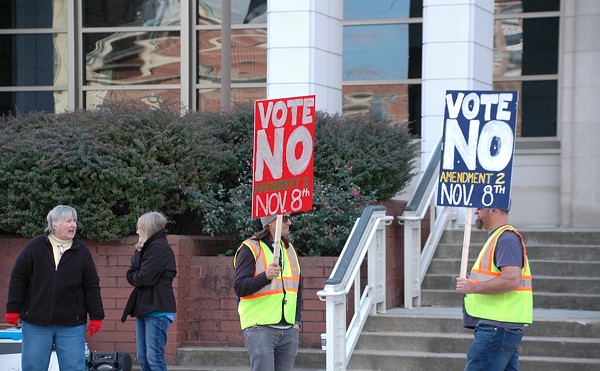Among a standing-room-only crowd at a former Catholic church in South Cumminsville, a swath of green t-shirts materialized Aug. 16 on residents opposing a budget proposal that would dismantle Cincinnati's Office of Environmental Quality (OEQ).
The public hearing of City Council's Budget and Finance Committee began with City Manager Milton Dohoney Jr.'s presentation and defense of his proposal, and concluded only after 36 residents had responded before the committee. Council will vote on the plan Aug. 31.
Among those who addressed council, 18 spoke in support of continuing to fund OEQ, with two using the phrase “penny-wise and pound-foolish” to describe the proposal; none defended it.
“Why on earth are you even considering dismantling an office whose effect on the budget alone is positive, in excess of 25 times its cost?” William Messer asked council.
City statistics reveal the single OEQ project of overhauling Cincinnati's recycling program this year will save more money — $930,731 in 2011 — than the city expects to save by eliminating the office, which is estimated at $225,030 by 2012.
Also, Dohoney's report noted the $23 million in federal grants that OEQ has helped win for the city since it was founded in 2007, for projects like cleaning up contaminated “brownfield” sites for redevelopment and energy retrofits to city buildings that save an additional $1 million each year.
Columbus pulls, Washington pushes
The proposal to abolish OEQ comes in response to Gov. Kasich's latest budget, which has lopped 50 percent off the state's Local Government Fund, at a cost to Cincinnati of $13 million by 2012. Kasich's repeal of Ohio's 43-year-old Estate Tax will blot out another large source of local revenue, effective in 2013.
Meanwhile, the target placed on OEQ mirrors even larger cuts made to state environmental agencies.
One of Kasich's first executive orders was to eliminate the Ohio Department of Agriculture's Office of Sustainable Agriculture, and his recent budget plan liquidates Ohio's 40-year-old Air Quality Development Authority (AQDA).
The federal government, however, continues to offer stimulus grants for “green collar” projects, which OEQ has been scooping up.
In 2009 the American Recovery and Reinvestment Act awarded over $3.5 million to energy efficiency and conservation projects in Cincinnati. And in 2010 the U.S. Environmental Protection Agency selected Cincinnati for a $200,000 grant to train and certify 60 students from brownfield-blighted communities, for environmental jobs like site clean-up and green construction.
According to a report by the Brookings Institute, Cincinnati's green job sector has grown steadily since OEQ was formed in 2007, after a year-long plateau. As of 2010 the largest segments of the city's green economy were public mass transit, waste management and treatment, and energy saving building materials, which together provided 8,248 jobs.
And the Washington, D.C.-based Institute for Local Self-Reliance reports that nationwide, recycling programs generate at least 35 times more jobs than landfill disposal systems.
In the meantime, Cincinnati State has become a regional leader in training green builders, auditors, and sustainability managers to fill this growing sector.
Tortured Explanations
A financial centerpiece of Dohoney's plan is the dismissal of Sue Magness, orchestrator since 2009 of the city's profitable but still-young recycling program enhancements. Magness earns about $52,000 per year.
According to the Hamilton County Solid Waste and Recycling District, the recycled portion of Cincinnati's waste has risen from 12.32 to 17.37 since Magness was hired, earning the city an additional $4 per ton under a county-wide incentive system.
Since 2007 the number of Cincinnatians who use curbside recycling has nearly doubled, from 38 percent to 71.5 percent.
Dohoney has named two city departments — Public Services and the Metropolitan Sewer District — as possible new homes for the recycling program, but he hasn't said how Magness' full-time responsibilities would be delegated to existing employees.
Nor does Dohoney suggest that OEQ's functions would continue unscathed if they were spread among multiple departments, as per his proposal.
“Obviously, you lose some of the synergy that you have when they are collected in the same office,” Dohoney says, citing the current budget gap as his only reason for dismantling OEQ.
But some City Council members see other good reasons.
Charterite Chris Bortz, along with Leslie Ghiz and Councilman-turned-County Commissioner Chris Monzell, both Republicans, have all supported dissolving OEQ, arguing that it duplicates too many of the services provided by the state- and federal-level Environmental Protection Agencies.
As an example, Ghiz and Monzell point to OEQ's role in enforcing local air quality standards — a job which normally falls to the Ohio EPA.
Monzell also emphasizes the wastefulness of OEQ's involvement in the recycling program, suggesting that the district could run the program or Rumpke could manage its own contract.
But according to district spokesperson Michelle Balz, that agency's sole mandate is to turn landfill “tipping fees” from companies like Rumpke into incentives for local municipalities to increase their recycling and decrease their waste.
“We're trying to put ourselves out of business, really,” Balz says.
Although Rumpke does offer its own recycling “subscriptions” to households in townships without public contracts, the company does relatively little business in those places.
“The contracted areas typically do a lot better as far as participation rates,” says Rumpke spokeswoman Amanda Pratt. “When we can ensure that the maximum amount of people are recycling, that's a win-win for Rumpke, as well as the community and the world.”
City Councilwoman Laure Quinlivan, a Democrat who heads the mayor's Green Steering Committee, is fighting to preserve the OEQ even if downsizing is necessary, calling it “a hub for people coming together and doing good things.”
Also, Quinlivan cites job growth enabled by OEQ's projects such as the current construction of a MedPace research laboratory facility in Madisonville. The company, which is building on 29 once-unuseable acres thanks to a grant-funded soil and groundwater remediation project, plans to create 800 new jobs by the end of 2014.
In the face of these benefits, Quinlivan explains opposition to OEQ as “ideological,” and the city manager's proposal as an effort to appease council members who are simply uncomfortable with a city office acting on environmental values.
But Ghiz, who calls herself “one of the best and biggest fans of recycling,” and Bortz, who says environmental values have become as widely-embraced as “mom, apple pie, and puppies,” both distance themselves from the push to cut OEQ, suggesting that Dohoney has managerial reasons for proposing it, to which they they aren't privy.
When asked to characterize OEQ's relationships with the business community, however, Bortz says that “the broader industry has been very opposed the City's Environmental Justice (EJ) Ordinance.”
The first such ordinance in the nation, the EJ Ordinance explicitly combats the concentration of polluting industries in poor and minority communities, by requiring companies to follow a strict protocol of local research and disclosure before expanding into a new neighborhood. And OEQ has the task of implementing the ordinance.
In fact, the Cincinnati USA Regional Chamber of Commerce lobbied vigorously against the ordinance's passage in 2009.
Ellen van der Horst, then the Chamber’s president and CEO, wrote a letter in spring 2009 to the mayor and City Council urging that the ordinance be rejected.
“In its current form, the proposed ordinance would have a significant negative impact on business development,” van der Horst wrote. “At a time when the city of Cincinnati faces a projected $40 million budget deficit, creating a new unfunded mandate detrimental to business growth could only have a negative impact,” the letter added. “Without significant business growth, the city’s tax revenues will likely decrease and it will become more difficult to reduce the city’s projected deficit.”
Pressure from the business community may, then, explain some of the legislative opposition to OEQ.
Residents will be able to probe into the roles played by industry, ideology, and economy in this budget decision, during an October candidate forum organized by Ohio Citizen Action around environmental policies. The group is soliciting questions for the candidates at [email protected].





